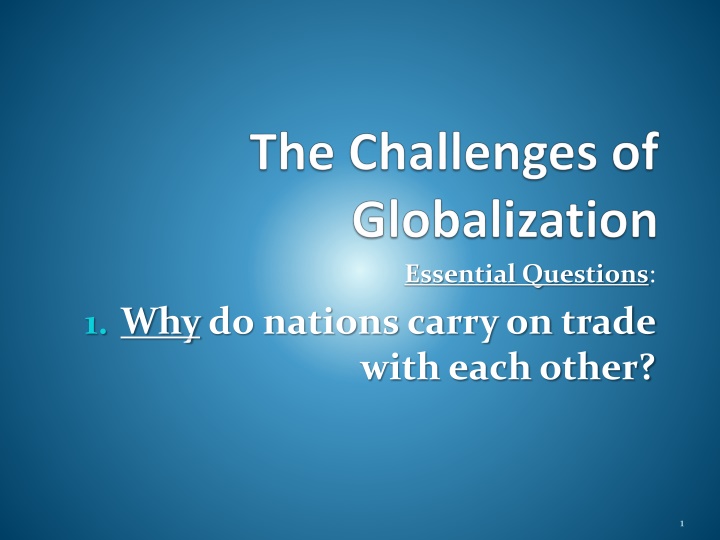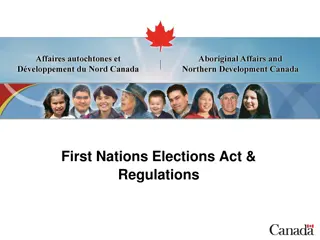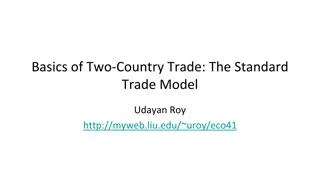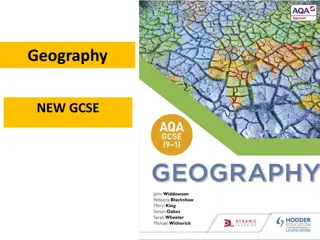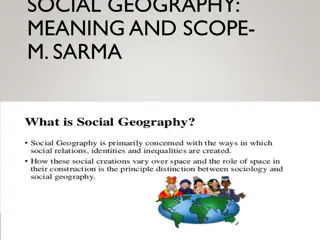Nations Trade: Why and How Geography Shapes Economic Activities
Nations engage in trade due to various factors, including productive resources influenced by geographic factors like natural resources, human resources, capital resources, and entrepreneurship. The location of economic activities is impacted by physical geography, climate, natural transportation routes, and infrastructure. Geography plays a crucial role in determining access to consumers, affecting the success of businesses based on proximity and transportation improvements.
Download Presentation

Please find below an Image/Link to download the presentation.
The content on the website is provided AS IS for your information and personal use only. It may not be sold, licensed, or shared on other websites without obtaining consent from the author.If you encounter any issues during the download, it is possible that the publisher has removed the file from their server.
You are allowed to download the files provided on this website for personal or commercial use, subject to the condition that they are used lawfully. All files are the property of their respective owners.
The content on the website is provided AS IS for your information and personal use only. It may not be sold, licensed, or shared on other websites without obtaining consent from the author.
E N D
Presentation Transcript
Essential Questions: 1. Whydo nations carry on trade with each other? 1
Productive Resources Geographic factors, such as landforms, climate, natural resources, areas of human settlement, and infrastructure influence the location of economic activities. Natural Resources: those provided by nature, such as minerals, plant fibers or coal for energy. Human Resources: All the human labor required to produce something. 2
Productive Resources contd Capital Resources: Goods used to make other goods or services. This also includes infrastructure: technology, transportation routes, communications. Entrepreneurship: The people who bring together and organize all of the other productive resources. 3
How Geography Affects the Location of Economic Activities Physical Geography: Determines where many of the productive resources that go into making a good or service are located. Climate: influences the types of crops grown. Natural Resources: Where minerals and raw materials are located can affect the location of an economic activity. 5
How Geography Affects the Location of Economic Activities cont d Natural Transportation Routes: Rivers, lakes, oceans Infrastructure: Includes investments in roads, railroads, electricity and the Internet. 6
Geography Affects Access to Consumers Physical barriers like mountains, forests, deserts, and some water bodies can make it difficult or impossible to bring resources to consumers. Flatlands, valleys, and rivers often help to bring productive resources to consumers. 7
Geography Affects Access to Consumers Cont d Business that are closer to consumers will often be more successful. Improvements in transportation, shipping and communications can lower costs and make areas formerly unreachable more accessible. 8
Specialization Leads to Trade Unequal Distribution of Resources: Regions and countries have different natural resources, human resources, capital resources and entrepreneurship. Example: Petroleum 9
Specialization Leads to Trade contd Specialization: Countries specialize in producing those goods and services that they make best, based on their available resources. 10
Specialization Leads to Trade contd Trade: To obtain other products, countries exchange the goods they make with other countries through trade. 11
Global Trade Patterns Since ancient times, peoples have traded goods with distant neighbors. In the Middle Ages, Constantinople, the Islamic world and West Africa were centers of trade. 12
Global Trade Patterns contd The Columbian Exchange shifted major trade routes from the Mediterranean to the Atlantic. In the 1800s, European colonial empires increased global specialization. 13
Causes of Globalization The recent lowering of trade barriers. Rise of Free Trade Associations: GATT (General Agreement on Tariff and Trade, 1947) NAFTA (North America Free Trade Association, 1990 s) World Trade Organization; EU (European Union) 14
Causes of Globalization contd Spread of new information technologies. Transportation improvements. Outsourcing: When companies hire other companies to do some of their work. Offshoring: When companies move operations to countries with lower labor costs. 15
Review Japan has few natural resources, but it has one of the most highly developed economies in the world. What best explains this achievement? A. It imported manufactured goods. B. It developed technologies that can be exchanged for the resources it needs. C. It printed more money whenever living standards started to decline. D. It produced goods and services without using natural resources. ANSWER: B 16
Review Which statement provides an important reason why countries and regions specialize in their economic activities? A. They become more self-sufficient. B. They do not wish to compete. C. They have different productive resources. D. They are unable to overcome trade barriers. ANSWER: C 17
Review Countries generally specialize in producing particular goods. What is one result of such specialization? A. Production and consumption gradually decrease. B. Countries depend on trade to obtain other goods. C. Countries become less interdependent. D. Prices increase as many goods become more scarce. ANSWER: B 18
